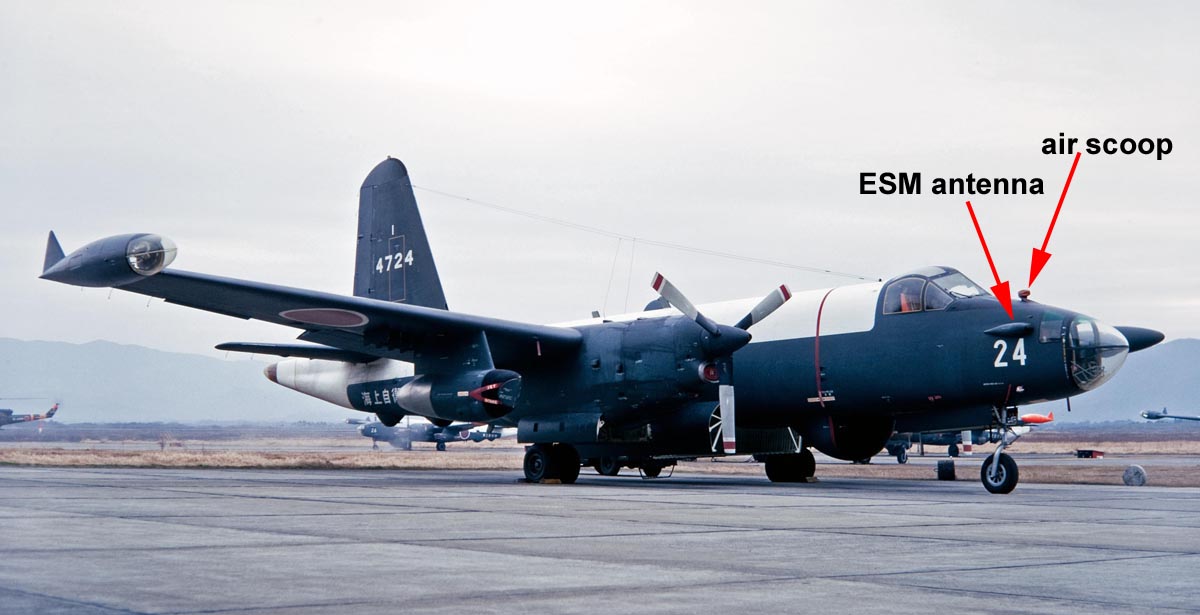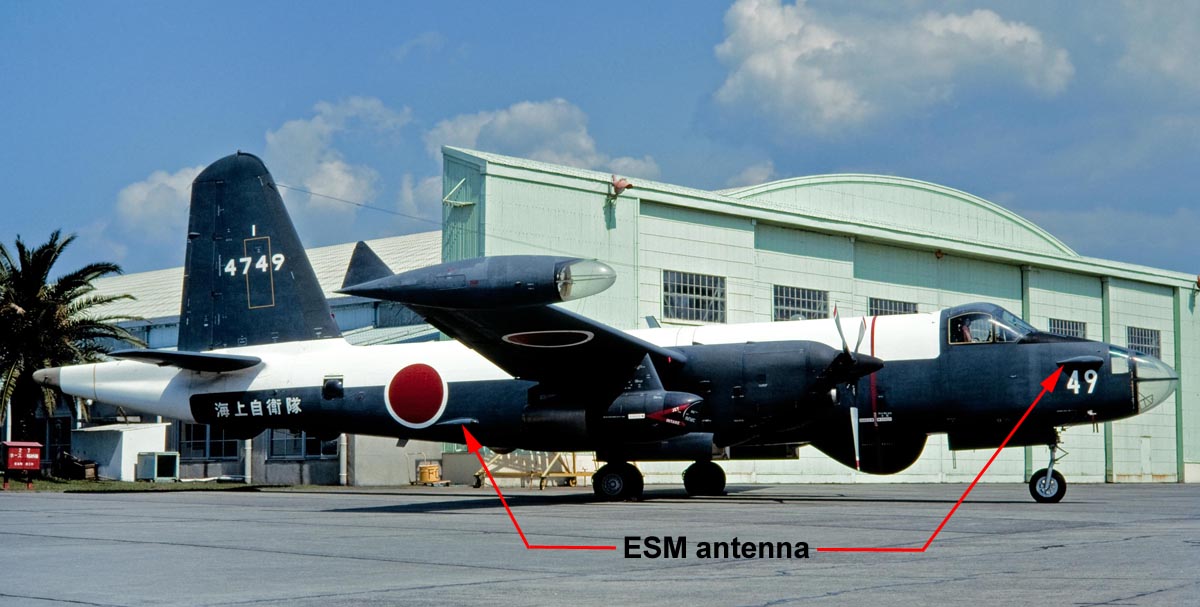
A P2V-7 #4637 was re-engined with two GE.T64 turboprops as the prototype P2V-7-KAI and renumbered #4701, making its first flight on 21JUL66.
The P2V-7-KAI entered production as the "P-2J".
A total of 82 P-2Js were built by Kawasaki with the serials 4702/4783, and the first one (#4702) was delivered in August 1969.
The P-2J gradually replaced the P2V-7 in service and the last machine (#4783) was delivered on 14MAR79.
The P-3C Orion gradually replaced the P-2J in service from the mid-1980s, and the last two surviving P-2Js were withdrawn from use in May 1994.
None of the P-2Js were lost by accident throughout it operational days from 1969 until 1994.
Color-scheme is dark grey overall with white roof.
日本のマニアの皆様にとってはお馴染みのP-2Jですので、日本語での解説文は割愛させていただきます。
1st Kokutai(Air Sqdn), 第一航空隊
 P-2J
P-2J
4724
@ Kanoya
05MAR73
 P-2J
P-2J
4749
@ Kanoya
10APR88
 P-2J
P-2J
4781
@ Kanoya
10APR88
(above three photos)
These three photos show P-2Js operated by the 1st Kokutai(Air Sqdn.) stationed at Kanoya.
There were some differences in external appearance for the P-2Js.
Most noticeable differences were (1) an "air scoop" for the Sniffer on the nose, and (2) two pairs of ESM antenna fairings on both sides of the nose and the mid-fuselage.
Please see the top photo of #4724.
The #4724 carried both the air scoop on the nose and the ESM antenna fairings as shown on the top photo with red arrows.
The Sniffer system with nose air scoop was removed from the 47th machine(serial 4748), so you cannot find the "air scoop" on the P-2J #4749 shown on the middle photo.
The ESM system was upgraded from the 55th machine and the antenna fairings were removed from the P-2J #4756.
So, you cannot find the ESM antenna fairings on the P-2J #4781 shown on the bottom photo, which did not carry the air scoop neither.
(上3枚)
これらの写真は鹿屋基地をホームベースとしていた第一航空隊のP-2Jです。
P-2Jには時系列的に細かな外観変化がいくつか有るようですが、最も見分け易い外観変化は、(1)機首上部のエアスクープ(スニファー用)と、(2)ESMアンテナフェアリングだと思います。
最上段の写真(4724号機)ではエアスクープもESMアンテナフェアリングも付いています。
しかし、4748号機からはシュノーケルの排気を探知するスニファーが取り外されたので、機首のエアスクープが無くなりました。
よって、中段写真の4749号機ではエアスクープが付いていません。
また4756号機からは、ESMがHLR-1からHLR-101に換装されたため、アンテナ・フェアリングが無くなりました。
よって、最下段写真の4781号機では、エアスクープもアンテナ・フェアリングも無くなり、機首の形状がスッキリしています。(プラモ的には楽ですね)
.
 P-2J
P-2J
4729
@ Tsuiki
06NOV83
(above photo)
Above photo shows another P-2J of the 1st Kokutai, which was displayed at Tsuiki airshow in November 1983.
The 1st Kokutai was the only P-2J Kokutai which did not have its tail-markings at all.
Speaking from the photographers view point, I didn't like it (Ha-Ha!!).
The 1st Kokutai had operated the P-2J from 1971 until 1989 and the unit became the P-3C Orion squadron in 1989.
(上写真)
この写真は1983年の築城航空祭で地上展示されていた第一航空隊のP-2Jです。
同隊は1971年にP2V-7から機種改変しましたが、1989年にはP-3C航空隊となりました。
一度も尾翼に部隊マークを描いた事がないユニークな航空隊ですが、写真マニア的にはかなり残念な航空隊です。
.
2nd Kokutai(Air Sqdn), 第二航空隊
 P-2J
P-2J
4717
@ Hachinohe
14OCT72
 P-2J
P-2J
4716
@ Hachinohe
14OCT72
(above two photos)
I visited Hachinohe Air Station (near Misawa Air Base) for the first time in October 1972 and I took the above P-2J photos of the 2nd Kokutai at that time.
The 2nd Kokutai began receiveing P-2J on 28APR71 and the unit received the first three P-3C Orions on 20JUL85.
They are currently flying P-3C Orions from Hachinohe Air Station.
The tail marking of the 2nd was a stylized "VP2" from top to bottom in red on the white base.
(上2枚)
1972年10月に小生は初めて八戸基地を訪問しました。上の写真はその時に撮った第二航空隊のP-2Jです。
同隊は1971年にP2V-7からP-2Jへの機種改変を始めましたが、それから14年後の1985年にはP-3Cへの改変を始めています。
VP-2をデザイン化した尾翼の部隊マークですが、小生が八戸を訪問した前年の1971年から採用されたと記憶しています。
よって、とても目新しいと感じたのを覚えています。
.
3rd Kokutai(Air Sqdn), 第三航空隊
 P-2J
P-2J
4750
@ Atsugi
01NOV76
 P-2J
P-2J
4758
@ Atsugi
01NOV76
 P-2J
P-2J
4752
@ Atsugi
01NOV76
(above three photos)
Above photos show P-2Js of the 3rd Kokutai which I photographed at their home base Atsugi in November 1976.
The 3rd Kokutai began receiveing P-2J on 06JUL74 and the unit received the first P-3C Orion on 10MAY84.
They are currently flying P-3C Orions from Atsugi Air Station.
The tail marking of the 3rd was......The orange figure stylizes a letter "A" and the green one stylizes a letter "T",
and these two letters are the first two letters of "ATsugi" where the 3rd Kokutai is homebased.
The orange figure also represents the shape of a snow-capped Mount FUJI as Atsugi Air Station is located near Mt.Fuji.
(上3枚)
上3枚の写真は1976年11月に厚木基地の列線で撮影しました。
第三航空隊は1974年から約10年間に渡りP-2Jを運用し、10MAY84に最初のP-3Cを受領しました。
尾翼のマークは厚木の頭文字である"A"と富士山の形を模したオレンジの部分と、"T"(厚木のローマ字表記の二文字目)の形を模した緑色の部分が重なり合ってできています。
オレンジ塗料は退色しやすいようで、最上段写真の4750号機ではかなり濃いオレンジ(赤に近い)ですが、最下段写真の4752号機では退色が進んで白っちゃけたオレンジ色になっています。
.
4th Kokutai(Air Sqdn), 第四航空隊
 P-2J
P-2J
4769
@ Misawa
08OCT78
 P-2J
P-2J
4760
@ Shimofusa
13NOV84
 P-2J
P-2J
4756
@ Hachinohe
10MAY87
(above three photos)
Above photos show P-2Js of the 4th Kokutai homebased at Hachinohe.
Top photo (#4769) was taken at Misawa airshow in October 1978.
P-2J #4760 shown on the middle photo was on fainal at Shimofusa Air Station in November 1984.
I took the bottom photo (#4756) at Hachinohe airshow in May 1987.
The 4th Kokutai transittioned from P2V-7 to P-2J during 1978-1980, and they received their first P-3C Orion in 1986.
The unit is currently flying P-3C Orions from Hachinohe.
The tail marking of the 4th Kokutai was......The yellow figure was a stylized "4" representing the "4th" Kokutai,
and the white portion was a giant eagle came from the unit badge of the 4th Air Squadron.
Please note on the bottom photo(#4756) that two additional antennas(details unknown) are seen on the fin cap.
(上3枚)
上3枚の写真はいずれも第四航空隊のP-2Jです。
最上段写真の4769号機は1978年秋の三沢航空祭に飛来した機体です。航空祭が終り八戸に帰投するところです。
中段写真の4760号機は1984年11月に下総基地へ着陸するところを基地の外から撮りました。
下段写真の4756号機は1987年の八戸航空祭に地上展示された機体です。
シスタースコードロンの第二航空隊は一足先にP-3Cへ機種改変しており、隣に並べられています。
垂直尾翼先端に他の機では見られないアンテナ二本(詳細不明)が飛び出しています。
.
5th Kokutai(Air Sqdn), 第五航空隊
 P-2J
P-2J
4773
@ Naha
17AUG89
 P-2J
P-2J
4771
@ Naha
17AUG89
 (above & at left)
(above & at left)
These photos show P-2Js of the 5th Kokutai parked at their home base Naha, Okinawa in August 1989.
Okinawa Kokutai was formed on 16OCT73 with P-2J at Naha, Okinawa after the island of Okinawa reverted to Japan on 15MAY72.
The unit was reorganized and became the 5th Kokutai on 15JUL81.
The 5th transitioned from P-2J to P-3C Orion in 1990.
The tail marking of the Okinawa Kokutai (which later became the 5th Kokutai) was "Pegasus" as shown on the photo at left, which came from the call-sign of the squadron.
(上と左)
上2枚と左の小写真はいずれも1989年8月に那覇で撮影した第五航空隊のP-2Jです。
この時は10歳になった長女を連れての沖縄旅行だったので、長女を連れての那覇基地訪問でした。
クソ暑い中で写真を撮りまくる父親をエプロンの上で見ていた長女(現在は36歳のママです)は、お父さんの飛行機キチガイぶりを初めて見てしまいました。
沖縄返還に伴い編成されたP-2Jの部隊は当初沖縄航空隊と呼ばれており、テールコード(?)は"ナ"でしたが、15JUL81に第五航空隊となりました。
その後同隊は1990年にP-3Cオライオン航空隊となりました。尾翼マークのペガサスは同隊のコールサインからきているそうです。
.
7th Kokutai(Air Sqdn), 第七航空隊
 P-2J
P-2J
4762
@ Kanoya
10APR88
 P-2J
P-2J
4760
@ Kanoya
10APR88
(above two photos)
Above photos show P-2Js of the 7th Kokutai which I photographed at their homebase Kanoya in April 1988.
The 7th Kokutai was the last P-2J squadron newly established at Kanoya Air Station in 1987.
The last P-2J left the 7th Kokutai in May 1994 and the unit became a pure P-3C squadron after that.
The tail marking of the 7th Kokutai was a Greek letter "OMEGA" in blue outlined in white because it was a call-sign of the squadron,
together with yellow seven stars in the shape of the "Big Dipper" or the "Plough".
These seven stars represent the "7th" Kokutai.
(上2枚)
上2枚の写真はいずれも1988年の鹿屋航空祭で撮影した第七航空隊のP-2Jです。
早く会場に入ったら一般公開エリアがまだ仕切られておらず、フラフラと歩いて第一航空隊や第七航空隊のエプロンで写真を撮らせてもらいました。
背景の土手の上には満開の桜が写っています。
第七航空隊は最後に編成されたP-2J航空隊で、上述航空祭の前年1987年に新編されました。
同隊最後のP-2Jは1994年にリタイアしたそうで、その後P-3Cの飛行隊となりました。移行期間中はしばらく両機種を運用していたそうです。
尾翼の部隊マークは、同隊のコールサインであるギリシャ文字オメガと、第七航空隊を表す七つの星(北斗七星)です。
.
51st Kokutai(Air Sqdn), 第五十一航空隊
 P-2J
P-2J
4701
@ Shimofusa
MAY74
 P-2J
P-2J
4716
@ Shimofusa
28MAY78
(above two photos)
The 51st Kokutai undertakes testing and evaluation of the JMSDF aircraft.
Please note the long red/white probe on the nose on both aircraft 4701(top) & 4716(bottom).
Please note also the orange fuselage band and the horizontal orange stripe on the wing-tip tank, which represented that these P-2Js were special test planes.
Top photo shows a P-2J #4701, which was originally a P2V-7 serialed #4637.
It was re-engined with two GE.T64 turboprops as the prototype P2V-7-KAI and renumbered #4701, making its first flight on 21JUL66.
The P2V-7-KAI entered production as the "P-2J" afterwards.
Bottom photo shows a P-2J #4716, which was a specially converted aircraft named "Variable Stability Test" aircraft(VSA).
JMSDF once operated another VSA test plane converted from the P2V-7 #4655, which was quite unique in shape and color scheme.
However this P-2J(VSA) #4716 looked very similar to the normal P-2J aircraft.
(上2枚)
これら二機のP-2J(4701と4716号機)は外観上よく似ていて、通常対潜型のP-2Jとはちょっと違っています。
一番目立つのが機首に装備された赤白の長い計測プローブです。
塗装面でも後部胴体のオレンジ帯や翼端タンクのオレンジ・ストライプは通常対潜型P-2Jでは見られません。
上段写真の4701号機は元々P2V-7の4637号機で、P-2Jを開発するために改造・試作された元『P2V-7改』です。
下段写真の4716号機はVSA実験機として使用されていた機体だそうです。P2V-7を改造した先代のVSA機(4655号機)に比べると外観的にもあまり特徴が有りません。
.
 P-2J
P-2J
4756
@ Hyakuri
OCT75
 P-2J
P-2J
4734
@ Shimofusa
29MAY77
 P-2J
P-2J
4778
@ Iruma
03NOV85
(above three photos)
Top photo shows a P-2J #4756 of the 51st Kokutai, which I photographed at Hyakuri airshow in October 1975.
I took the middle photo of P-2J #4734 at Shimofusa airshow in May 1977.
The aircraft was taxing on the flight line to the runway for its demo-flight.
Bottom photo shows a P-2J of the 51st Kokutai, which was taxing to the runway at Iruma for taking-off on its way back to Atsugi Air Station at the end of Iruma airshow.
(上3枚)
最上段の写真は1975年の百里航空祭で展示された4756号機です。
中段の写真は1977年の下総航空祭でデモ飛行に向かう第51航空隊の4734号機です。
背景には列線に並ぶP-2Jや、遠くには航空祭の見学者が写っています。
下段の写真は1985年の入間航空祭での撮影ですが、地上展示を終え厚木基地へ帰投するためにタキシングしてきた4778号機です。
.
205th Kyoiku Kokutai(Air Training Sqdn), 第205教育航空隊
 P-2J
P-2J
4762
@ Shimofusa
07JUN87
 P-2J
P-2J
4747
@ Shimofusa
07JUN87
 P-2J
P-2J
4733
@ Shimofusa
25MAY86
 (above & at left)
(above & at left)
The 205th Air Training Squadron undertook training for the P-2J crew at the time when I took the above photos during the 1980s.
The unit was originally established at Kanoya with four R4Ds(C-47s) on 01SEP61.
The 205th moved from Kanoya to Shimofusa with six YS-11Ts on 16FEB74, and they began receiving P-2Js in 1974.
After that, they had operated both P-2Js and YS-11Ts at Shimofusa for many years until the early 1990s when the P-2Js were withdrawn from service.
Then the unit became a pure YS-11T unit and it was disbanded on 01JUN11.
They started applying their tail marking (as shown on the photo at left) on both P-2Js and YS-11Ts in 1978.
This "TB" marking came from their call-sign "Tom Boy".
Please note the wing-tip tanks painted in dayglo orange.
The orange tanks were used on P2V-7s and P-2Js used by the training squadrons to improve visibility.
(上と左)
いずれも下総の航空祭で撮影した第205教育航空隊所属のP-2Jです。
当時同隊は下総でP-2JとYS-11Tを運用しており、P-2J搭乗員の訓練を行っていました。
同隊でのP-2Jの運用は1974年から始まり、1990年代始めには全機リタイアしたようです。
コールサインの"Tom Boy"に由来する"TB"の尾翼マークは1978年から付けられました。
また、これら訓練用に使われたP-2Jは翼端タンクがオレンジ色に塗装されていました。
.
81st Kokutai(Air Sqdn), 第81航空隊
 UP-2J
UP-2J
9161
@ Iwakuni
07AUG83
 Firebee
Firebee
Same as above
(above two photos)
Above photos show a UP-2J #9161 and a Firebee target drone under the wing, which were displayed at Iwakuni airshow in August 1983.
A total of four P-2Js were converted to special-purpose variants designated as "UP-2J" with the serials 9161/9164 during 1979-1984.
The first two UP-2Js (#9161/62) were converted from the P-2Js of #4717 and #4719 respectively and they were delivered in 1979.
These two UP-2Js were used for various support duties for the fleet such as target-towing, drone-launching and ECM training.
The transparent nosecone was replaced with the solid rademe as show on the top photo.
Please note a total of ten recovery markings with parachutes painted in white on the Firebee.
(上2枚)
1983年夏の多分チビヤン公開の時だったと思いますが、このUP-2J(9161号機)の写真を撮りました。
嬉しいことにファイアビーを吊り下げての地上展示でした。ファイアビー側面には10回のリカバリーを表していると思われる白のパラシュート付きマーキングが描かれていました。
1979〜1984年にかけてP-2Jから改造された計4機のUP-2Jの内、
最初の二機(9161/62号機、元4717/19号機)はBQM-34Sファイアビーを搭載でき、またスリーブ曳航装置やミサイル・シーカーヘッドなども装備されているそうです。
.
 UP-2J
UP-2J
9162
@ Iwakuni
07AUG83
 UP-2J
UP-2J
9162
@ Iwakuni
21JUL85
(above two photos)
Above photos show a UP-2J #9162 of the 81st Kokutai which I photographed at their home base Iwakuni in 1983/85.
Please note.....(1) the solid radome on the nose, and (2) additional three large bumps(fairings) under the lower fuselage.
The 81st Kokutai was formed at Iwakuni with three UP-2Js on 30MAR83, and the fourth UP-2J joined the 81st in the following year.
The unit is currently operating EP-3 and OP-3C Orions at Iwakuni.
(上2枚)
1983年と1985年の公開日(チビヤン?)に撮影したUP-2J二号機(9162)の写真です。
前出の9161号機に比べると外観に違いがあり、最も目立つのは胴体中央下面の大きな出っ張りですが、更に後部下面には小さめの二つの出っ張りが隣り合わせに付けられています。
機首がソリッドノーズになっているのは9161号機と同じです。
第81航空隊は当初三機のUP-2Jを装備して岩国において30MAR83に新編されましたが、翌年にはUP-2Jの四号機が加わり計四機体制となりました。
同隊は現在EP-3とOP-3Cを飛ばしているそうです。
.

 P-2J
P-2J  P-2J
P-2J  P-2J
P-2J  P-2J
P-2J  P-2J
P-2J  P-2J
P-2J  P-2J
P-2J  P-2J
P-2J  P-2J
P-2J  P-2J
P-2J  P-2J
P-2J  P-2J
P-2J  P-2J
P-2J  P-2J
P-2J  (above & at left)
(above & at left) P-2J
P-2J  P-2J
P-2J  P-2J
P-2J  P-2J
P-2J  P-2J
P-2J  P-2J
P-2J  P-2J
P-2J  P-2J
P-2J  P-2J
P-2J  P-2J
P-2J  (above & at left)
(above & at left) UP-2J
UP-2J  Firebee
Firebee  UP-2J
UP-2J  UP-2J
UP-2J